Was the first president of the United States a Black man? ‘President’ John Hanson? Yes or No?
By Brother Student Minister Nuri Muhammad , with the NOI Research Group
 (Final Call, January 2, 2012) – There are a lot of myths that we’ve been burdened with in the name of history: Washington cutting down cherry trees, Lincoln freeing the slaves, savage Indians, happy slaves, just to name a few. Many of these lies are propagated by movies and television, but many of these deliberate falsehoods have been found in the history textbooks of our own children’s schools. One white professor named James Loewen studied the twelve leading high-school American history textbooks and concluded that they were “marred by an embarrassing combination of blind patriotism, mindless optimism, sheer misinformation, and outright lies.” He found so much deception, fabrications, and falsehoods that he wrote a fat 400-page book titled, Lies My Teacher Told Me: Everything Your American History Textbook Got Wrong.
(Final Call, January 2, 2012) – There are a lot of myths that we’ve been burdened with in the name of history: Washington cutting down cherry trees, Lincoln freeing the slaves, savage Indians, happy slaves, just to name a few. Many of these lies are propagated by movies and television, but many of these deliberate falsehoods have been found in the history textbooks of our own children’s schools. One white professor named James Loewen studied the twelve leading high-school American history textbooks and concluded that they were “marred by an embarrassing combination of blind patriotism, mindless optimism, sheer misinformation, and outright lies.” He found so much deception, fabrications, and falsehoods that he wrote a fat 400-page book titled, Lies My Teacher Told Me: Everything Your American History Textbook Got Wrong.
In our sincere desire to inspire the Black Man and Woman, we sometimes latch onto those enticing tidbits of historical folklore that seem to show us in our original greatness. The story of John Hanson is one of those legends that have permeated our Black consciousness, and it is easy to see why. Many have claimed that Hanson was the first president of the United States—not George Washington—and, they say, he was a Black man! Could it be that the Founding Fathers of America had to rely on a Black man to lead them out of the darkness of a European monarchy? And what Black person wants to claim the role or position of George Washington—a Virginia-born Caucasian who enslaved at least 500 African people, and murdered untold numbers of Indians—whereby he presided over slavery? The idea is indeed captivating, especially for a people who have always been told they were at the bottom of every socio-political and economic measure.
The idea of a Black John Hanson—“first President of the United States”—has become a popular legend in the Black community, but is it true? Let’s take a closer look. The question arises around a merchant from Maryland named John Hanson who lived during the era of the American Revolutionary War (1775–1783), when the Europeans who first came over to colonize America took up arms to separate from Britain. Hanson became a leader at the 1780 Continental Congress held in Philadelphia, where representatives from all the colonies assembled to present a unified front to the European powers. They had not yet decided to become a nation, but they did want to form some organization to protect their interests. So they formed an organization, very much like NATO (North Atlantic Treaty Organization) of today, and they elected John Hanson to lead them. But the “United States” as an actual nation would not be formed until the U.S. Constitution was ratified in 1788—five years after Hanson’s death. That is when plantation owner George Washington became the new nation’s first president.
So Hanson was not Black; nor was he the first president of the United States—but how did so many people come to believe that Hanson was a Black man? The racial mislabeling of John Hanson seems to be a simple case of mistaken identity. Some have confused the colonial-era John Hanson with a politician from the African nation of Liberia who lived decades later in the mid-1800s. This Liberian John Hanson was notable for his involvement in the resettlement of former slaves in Africa. While this Liberian Hanson was indeed Black, he lived well after the Hanson of the Continental Congress.
But then there is the question of the portrait on the back of the $2 bill, where some say that John Hanson is depicted as a Black man. Well, the picture is an artist’s depiction of the scene at the signing of the Declaration of Independence in 1776 and shows several Caucasians in the room. One of those powder-wigged men depicted (the 12th from the left) appears darker than his colleagues, leading to speculation that it is their Black John Hanson.
But in reality, if there were Blacks in the room, they were slaves—not diplomats or politicians. In any event, the white John Hanson never signed the Declaration of Independence, so even if the engraver meant to depict a Black man (and he did not) it was someone other than Hanson.
Yet more confusion has been created by the existence of a photograph that clearly shows a man named John Hanson, and there is no doubt that he is a Black man. Our Liberian brother is the one in the photo, bespectacled, dignified, and of serious bearing. And there is one small technical issue that disqualifies him from being the first president: photography was invented around 1822, long after the 1783 death of the Caucasian Hanson and 23 years after George Washington took his last breath.
So we now must put to rest this worn-out urban legend, and those of us who have erroneously taught it must strive to find better and historically accurate ways to illustrate Black people’s leadership qualities. The Caucasian John Hanson was an avowed enemy of Black and Indian freedom, justice, and equality. And we should be careful not to insert a Black man into leadership over one of the bloodiest chapters in the history of our people. Our Black heroes fought mightily, valiantly, and too often futilely against everything that John Hanson stood for—good white supremacist that he was. Slave rebellion leaders Nat Turner, Denmark Vesey, Gabriel Prosser all qualify as true freedom fighters worthy of our abiding honor and respect. And today there is no one more deserving of the title “hero” than The Honorable Minister Louis Farrakhan. And though they don’t provide comfortable thoughts and memories for white people, soon they will be seen as our true Founding Fathers. Let the white John Hanson remain white. He would have wanted it that way.
But that doesn’t mean that the white criminals that flooded into America, having been expelled from the jails and dungeons of Europe, knew how to set up a government on their own. They still needed the Original Man for that—just not John Hanson. Upon his arrival, the white man found a welcoming and friendly people, members of a well-ordered agrarian society with a solid political, social, and spiritual structure and strong alliances with other Indian communities. Whites sailed the coast and couldn’t believe the great expanses of cultivated land expertly planted with corn, peppers, strawberries, beans, squashes, artichokes, grapes, and tobacco, with warehouses for their longterm storage.
They found no jails, no forts, no starvation, no native diseases that were not treatable or even curable by the medical experts among the Indians. In short, European whites found a natural harmony between the people and their land and, despite what Hollywood has promoted for years, an amicable co-existence with Indians from all other regions—a sharp contrast to the feudal self-oppression, chaos, war, death, destruction, and disease that characterized the 17th-century Europe that the Pilgrims fled. The Italian explorer Giovanni da Verazzano called the Indians “the most beautiful people and the most civilized in customs.” The famed Puritan Capt. John Smith called their land “a most excellent place for health and fertility.” It is, he said, “paradise.”
The Iroquois Nation lived by a pact they called the Great Law of Peace, which was in force throughout the entire Atlantic northeastern region. Under their government women held a position of high respect and authority, and they made no distinctions on the basis of race. But just as in Africa, whites like Benjamin Franklin were sent to study the indigenous communities they called “savages.” And when they came up with the design for the American Constitution, it had many of the same themes that were in the Iroquois Pact. Many scholars say there are so many similarities that it can be said (without hyperbole) that whites actually lifted the principles, ideas and themes from the Pact and called them the United States Constitution. The Iroquois Grand Council had fifty members (forty-nine living sachems and one seat perpetually reserved for the Peacemaker), while Benjamin Franklin’s plan had forty-eight. This is very much like the Congress we know in Washington today—except, of course, for the Peacemaker. Franklin was so impressed with the Indian government that he actually wrote a letter in 1751 encouraging the colonists to emulate the Iroquois model. (Franklin’s letter, anonymously published, was widely publicized.)
This is one of many actual historical facts that show the powerful role the Indian and the African had in forming the very core of the United States of America. In the future, learning about the role of the Black Man and Woman in creating governments will be a central part of our education system. The Honorable Minister Louis Farrakhan has declared that we are to be SEPARATED, to achieve our long overdue Freedom, Justice, and Equality. Let us start with our true history, separating it from the enemy’s myths, rumors, falsehoods and deceptions. Truth will guide us, and Allah will bless us!


